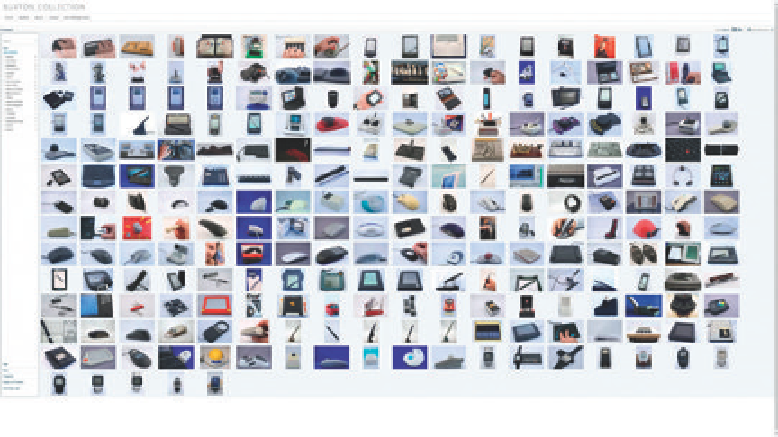Information Technology Reference
In-Depth Information
Fig. 8.17. Bill Buxton is a Canadian computer scientist and designer and a pioneer in the research
field of human-computer interactions. The Buxton Collection is a collection of interactive devices
that he has been collecting for about thirty-five years. The collection is intended as a resource for
those interested in design, user experience, and the history of interaction. Buxton is a principal
researcher at Microsoft Research and an expert on birch bark canoes.
configuration, and physical arrangement of a hardware device. Because these
devices can now be with us all the time new modes of interaction are threaten-
ing to displace the mouse as our primary interaction mechanism (
Fig. 8.17
).
The term
smart phone
was introduced by Ericsson in 1997. A smart phone
is just a mobile phone that uses a microprocessor-based computing platform
to provide the computing power we expect from a PC. The first smart phone
was the “IBM Simon” introduced in 1993. In addition to being a mobile phone
it served as a
personal digital assistant
, providing a calendar, address book, cal-
culator, notepad, and clock. Simon ran a version of DOS and could also play
games but only a few thousand were sold. In 2002, the Canadian telecommu-
nications company Research in Motion (RIM) introduced its first BlackBerry
smart phone, which combined the ability to send and receive email with the
capabilities of a mobile phone. We will explore the emergence of the Internet,
email, and the World Wide Web in
Chapters 10
and
11
. Easy access to email
and the web, together with the increasing availability of “Wi-Fi” allowing
wireless connectivity to the Internet, have been two of the key drivers for the
emergence of new portable computing and communication devices such as
smart phones and tablet computers.
Many companies have tried to market smart phones, tablets, and personal
digital assistants with a variety of different user interfaces. The history of touch
screen input goes back a long way. The first touch screen using capacitive
technology was invented by E. A. Johnson at the Royal Radar Establishment in
Malvern, United Kingdom, in the 1960s for an air-traffic control application.
The device works by sensing the change in electric charge caused by a finger
touching the screen. Another common type of touch technology used on Point
of Sale systems is based on the change in resistance caused by pressing on
a flexible surface. Other mechanisms for interacting with computers include

Search WWH ::

Custom Search